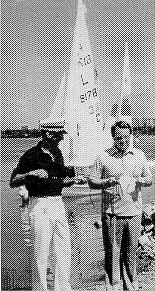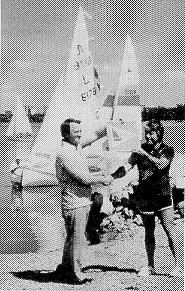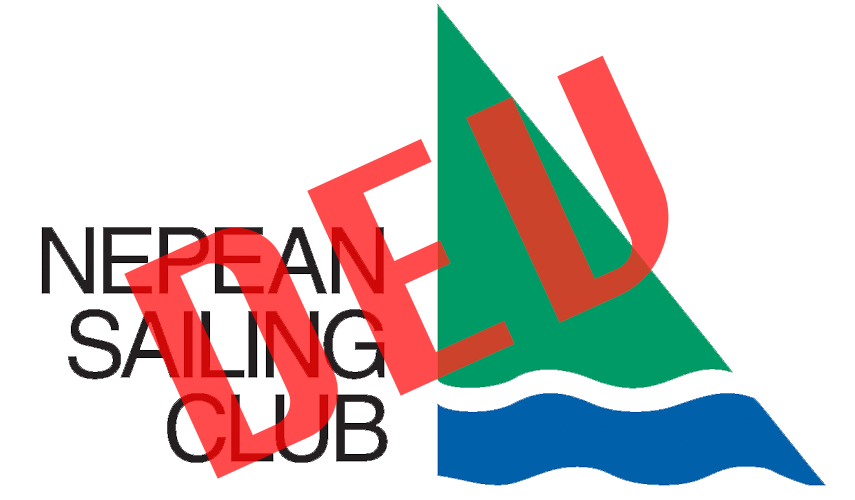An Abbreviated History of NSC, 1979-1994
This article was written by Michael McGoldrick in 1994 and first appeared in a special edition of the Telltale for the club’s 15th anniversary).
 |
 |
|
|
Commodore Gerry Gravelle and Mayor Ben Franklin are cutting the ribbon |
Mayor Ben Franklin and Past Commodore Bill Mantle with the new club Burgee |
Speak to anyone who was around when the Nepean Sailing Club first opened its doors and they will tell you that there was “absolutely nothing there” when describing the site where the Club’s facilities are currently located.
And when they say there was nothing there, they mean it! In the late 1970’s there was the embankment down from Carling Avenue, a few dozen yards of undeveloped land, followed by the shoreline of a shallow and very exposed corner of the Ottawa River. There was no breakwater, no yacht basin, no docks, no compound, no clubhouse, no… nothing.
Some fifteen years later we see a site and facility which compares favourably with that of any other yacht club in this corner of North America. There are now over a thousand individuals on NSC’s membership rolls, and hundreds of boats pour out of the Club’s yacht basin during the busy summer months. How did all this come about? Who started the club? How was a non-descript corner of Graham Bay transformed into what we now have in such a short period of time?
Answers to these questions are still fairly easy to come by. A surprising number of people who were originally involved in setting up NSC are still active club members. However, as the club grows and its ranks swell with new members, not everyone has a chance to talk to these people. As a result, and in order to mark the 15th anniversary of NSC, Telltale has attempted to piece together a short history of the Club’s early days.
The somewhat incomplete record we have at our disposal indicates that NSC’s story begins in December of 1978. At that time the Nepean City Council had just rejected a proposal to establish a “marina” on Graham Bay. Proponents of the project, including Brian Conway, did not give up. With the support of Andy Haydon, they managed to obtain the concession that the matter would be taken up by the newly elected council early the following year. But this new council was voted in to cut taxes, so no one was holding their breath.
The situation didn’t look too promising, and if things hadn’t changed, chances are that some of us would now be sailing out of Britannia or Dunrobin. Fortunately, things did change when “three guys from Harlowe Avenue” entered the picture. Bill Mantle and Jim Leeson knew of their mutual interest in sailing because they both had dinghies parked in their driveways at various times. Rounding out this trio from Harlowe Avenue was Keith Cattell. They had heard about the Council’s decision and figured it was time to promote the idea of establishing a sailing facility in Nepean.
The first thing they found out, according to Bill Mantle, was that the Nepean Council did not want anything to do with building facilities “so that rich guys could sit on their 30 footers drinking cocktails”. The second thing they found out was that if they were to have any chance of selling the project to the Council, they had to demonstrate that there was widespread community interest in sailing and that it was not an elitist sport. “Basically, we were pushing the line that sailing was a grassroots activity, and that it would attract the interest and participation of young people”, said Mantle.
With this strategy in mind, the group went about organizing a “Community Sailing Meeting” on December 18, 1978. The main subject of discussion was what to do next. It was soon decided that the best way of demonstrating community interest in sailing was not to wait for the decision of the Nepean Council, but to immediately establish a sailing club.
More than anything else, this decision represents the spiritual birth of NSC. Records indicate that three days later a document was drawn up listing the founding executive (steering committee) of the “Nepean Sailing Club”, and identifying Bill Mantle as the Interim President. From this point onwards, the club became the focal point for efforts to lobby the city council on the development of a sailing facility for Nepean.
These efforts soon paid off. Less than a month later, on January 9, 1979, the Nepean Council voted 7-0 to commit $90,000 toward the construction of a “sailing marina” on the Ottawa River. Mayor Ben Franklin told the press that the site would be in use by summer, but that the first phase of construction would not be completed before 1982. He also added that the facility would be run by the recently formed Nepean Sailing Club.
Although this was a major turning point for the club, the real work was just beginning. One of their first priorities was to build up the club through a membership drive. Bill Mantle said they soon put out the message “Calling all Sailors” and went about organizing a sailing night at the Nepean Sportsplex with “films, food, and that sort of thing to generate interest in the club”.
By the time the club officially opened with a ribbon-cutting ceremony on July 29, 1979, NSC had a membership of 120 families, for a total of 350 individuals. The first real Board of Directors had also been installed. Gerry Gravelle was selected as Commodore, apparently because he had been mooring his boat in Graham Bay for the previous four years, and thus had the most experience sailing in the area. Another nine people rounded out the list of board members, including Mayor Ben Franklin, Alderman Hugh MacDonald, and Bill Mantle, who assumed the duties of Past Commodore.
In those days, annual membership fees were $50 for families and $25 for seniors. A dry sail space would cost an additional $30 while keeping your boat on a swing mooring in the unprotected waters of Graham Bay would set you back $40 a year. Cheap by today’s standards, but fifteen years ago the club’s assets consisted of little more than a few dozen feet of plastic dock, wire fencing around the compound, and a small trailer which served as club headquarters.
The atmosphere and interaction at the club were obviously very different during its early days. The recollections of founding members such as Harry and Roberta Hayley can give us an insight into what things were like.
Roberta Hayley remembers how they first became involved in NSC as a result of an evening walk along the Ottawa River. They saw a fellow sitting near the shoreline doing something. It turned out to be Brian Conway who was keying together modular sections of plastic docks. He told them they were starting a sailing club, and invited them to attend the upcoming meeting at Nepean Sportsplex. Harry Hayley went to the meeting curious about plans to establish a club and came home as NSC’s first Harbour Master.
Harry Hayley was happy to be Harbour Master, but Roberta recalls that they, and the other members of the executive, would all race down to the club if a strong wind came up in the middle of the night. Because there was no breakwater the boats on the water were very exposed and would sometimes come loose from their moorings. Roberta said that people had to act quickly to prevent disasters, and she remembers that more than one boat had to be pulled off the rocks at Andrew Haydon Park.
During the early days, even the small accomplishments in establishing the club counted for a lot. Roberta Hayley said that members thought they were “in heaven” once they had the black plastic dock to land their tenders and dinghies. She also remembers how excited people were when the club’s flagpole was installed in time for the official opening ceremonies.
One of the funnier stories she has to tell about the club’s beginnings has to do with the fact that members on swing moorings had to have someone ferry them between their boat and the dock. When no one was available, these people had no choice but to swim in from their boats. Roberta remembers seeing this on numerous occasions. She also recalls that during the dark evening hours, you could sometimes hear a distant voice calling out “Could somebody come and get me?”
Roberta Hayley has fond memories of the challenges and comradery which existed at the NSC during its formative years. Back then the membership was still small enough so that just about everyone knew each other, kept an eye on each other’s boats, and pitched in to help develop the club’s facilities. There was a lot of hard work, but it was often followed by social events where everyone enjoyed themselves. These events often took the form of barbecues and get-togethers on the waterfront where people ate, drank a few beers, sang songs, and generally had a great time. Roberta also remembers a number of well-attended pizza parties in the middle of the night.
Building up the membership and developing a club identity is only half the story of how NSC got its start. The other half of the story has to do with the construction of the facilities we see today. This was no small accomplishment, and it is worth repeating that in the 1970’s there was almost nothing there. In fact, the shoreline of the Ottawa River almost came up to Carling Avenue.
Bill Levesque is the Director of Planning and Development for Nepean’s Parks and Recreation Department. He was working on plans for the site even before NSC existed and continued to be very supportive of efforts to develop club facilities during the past fifteen years.
In the summer of 1979, Bill Levesque described the construction of the 300-meter breakwater as a very ambitious undertaking. At the time he told the Ottawa Citizen that “700,000 cubic yards of fill would be needed to complete it,” adding “Each truck carries 10 tons, so you’re looking at 70,000 trips”. He said that all of this fill would be generated by local construction activity. As a result, the rate at which the breakwater would be built would serve as a barometer for the health of the local economy and construction industry.
Colin Nicholson is another person who was very active in the NSC during its construction phase. He joined the club during its first year and became NSC’s second commodore in 1981. He remembers large work parties of 40 or more people being organized to get on with the job of developing the new club throughout this period. Some of these work parties spent long hours building docks at the City of Nepean workshops.
By 1983 the breakwater was largely completed, though far skinnier than what we see today. Colin Nicholson recalls that the perimeter of the dry sail compound was also in place, but that its middle had yet to be filled. That summer the bottom of the harbour was dredged and poured into what was to become the middle of the compound area. In other words, the top of today’s dry sail area was yesterday’s harbour bottom.
1983 was also the year when the club acquired the grey structure which currently serves as the headquarters for the Sailing School. This building was a portable classroom and was used as a quasi-permanent clubhouse until 1990. Nicholson has vivid memories of going to the bank to arrange financing to purchase this building. From memory alone, he thinks that the portable classroom installed cost about $11,000.
Quite a few people view 1983-84 as an important transition point in the club’s life. The ad hoc – makeshift nature of the NSC was starting to vanish. A good proportion of docks that are currently in use had already been installed, and the overall layout of the site was similar to what we see today. The next major transition point seems to have occurred in 1990 when we opened the doors to our new clubhouse. More than anything else, the opening of the clubhouse symbolizes NSC’s coming of age. There are still a variety of new projects to be undertaken; the completion of the new “D” dock, landscaping, etc. But more and more of the work at NSC is shifting from a building to a maintenance & repair mode.
According to Colin Nicholson, the club has generally evolved as originally envisaged. He said that the initial plans called for a facility on the scale of what currently exists, and that members always expected the construction of the type of clubhouse we now enjoy. He adds that it was generally assumed that it would take a decade or more to complete all this work, which is pretty well what happened.
Gerry Gravelle, the club’s first commodore, agrees with Nicholson. He admits that he sometimes misses the atmosphere of NSC when it was a small club struggling to establish itself, but he says that he is very proud of what has been accomplished.
Gravelle also points out that the club has succeeded in providing Nepean residents easy access to the Ottawa River. In addition to being able to join the club or take sailing courses, all residents are able to take advantage of the launching ramp, and parking lots and park along the breakwater to enhance their enjoyment of the river. He stresses that this is especially important for a city whose territory includes only so much shoreline along the Ottawa River.
Written by Michael McGoldrick, based on research conducted by Brenda McCrea.
Michael McGoldrick, Ottawa, Ontario, Canada
e-mail: mcsail@magma.ca
2020-12-05: HM: Update log added. Though written in 1994, it appears this WordPress page was created on 2014-04-02 and last updated on 2015-04-22. There were a large number (53) of missing spaces between words; those spaces were re-inserted during this revision. A few very minor grammatical errors were corrected; otherwise, the article is unchanged, and thus no “page updated” is included. 2023-06-13, SF: Corrected some grammatical errors, shorten the title and created a subtitle with the name of the article.
